Family : Muscicapidae

Text © Dr. Gianfranco Colombo

English translation by Mario Beltramini

The redstart male in nuptial livery was once hurriedly mistaken with a robin © Gianfranco Colombo
The Common redstart or more simply the Redstart (Phoenicurus phoenicurus Linnaeus, 1758) belongs to the order of the Passeriformes and to the family of Muscicapidae, a more modern classification after having been assigned for very long time to that of the Turdidae.
The group of the Muscicapidae is the typical family of the palearctic flycatchers, as is rightly indicated by the etymology of the scientifc name, born from the fusion of the two Latin terms “musca” = fly and “capere” = to catch.
This family includes various species of birds among the most common in our territories, from the Robin (Erithacus rubecula) to the Spotted flycatcher (Muscicapa striata), from the lonely Ficedula flycatchers (Ficedula spp.) to the lively Wheatears (Oenanthe spp.).
Though the male of the redstart is one of the most coloured small birds of our avifauna, it is conversely standing among the most shy and reserved animals.
Once relegated to the margins of dense and mature woods with trees having gnarled trunks, riddled with all sorts of holes that furnished the ideal habitat where to nidify, nowadays the redstart has conquered our gardens and our homes, finding a much more congenial and good environment for its safety.
It has not abandoned its usual settlings but during the last decades more and more individuals have taken interest in our way of life and have settled discreetly among us often without giving any sign of their presence.
Perhaps the easiest period to observe it is the beginning of spring, when the male, anticipating by a few days the female, comes back from the African migration and shows to our country, still bare and barren the first spots of a colour that will then suddenly disappear by the first blooming, hidden into the foliage of the trees.
Oh yes, because this small bird so tiny and seemingly frail, undertakes extremely long and unthinkable migrations that have since ever created turmoil and confusion among the scholars of the time, as its sudden arrival and the following departure in late summer, moreover with different livery, overlapped with presences of other similar species, events interpreted imaginatively in various manners by the naturalists of the time. Already Aristotle, then Pliny and for some time also Linnaeus himself, more or less unaware of the existence of a real migration, thought that through a magic mechanism of the nature, this winter bird transformed into a Robin (Erithacus rubecula) and then did come back on the following spring again as a redstart, borrowing from other beliefs that saw the Common cuckoo (Cuculus canorus) becoming Sparrowhawk (Accipiter nisus), the Swallows (Hirundo rustica) hibernating in the bottom of the lakes and many other assumptions.
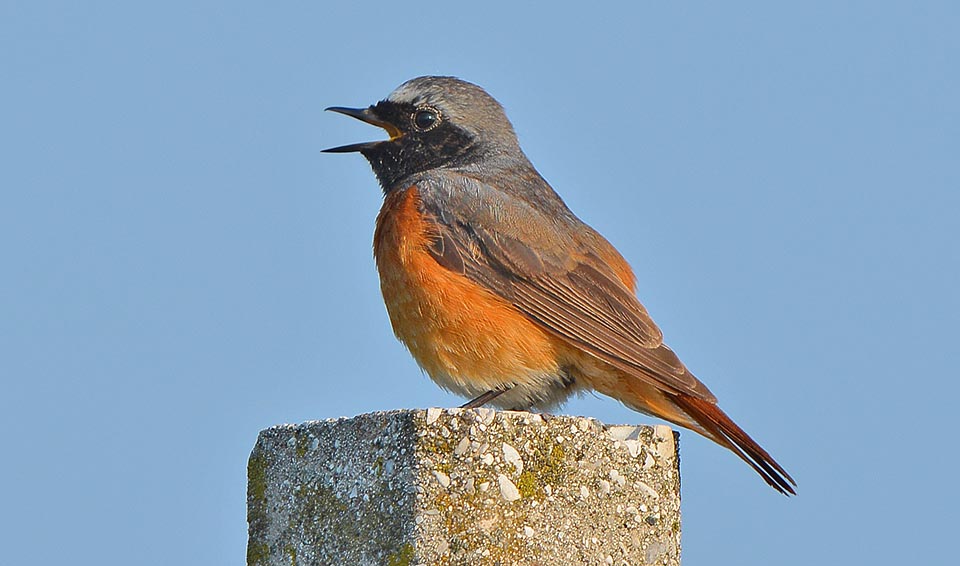
The males in fact come in spring, rightly when the robin leaves, some days before the females for delimiting immediately their hunting territory with their song © Colombo
Then there is to be added that in the palearctic, rightly in late autumn, we can observe a somewhat emblematic overlapping of species, not easy to undestand for the common people, and even less plausible, seen that they are basically two small birds not only similar but also belonging to the same genus.
When the common redstart goes away to the African warmth, its close cousin, the Black redstart (Phoenicurus ochruros) comes down from the north or from the high mountains and settles for wintering, in the same territory left free by the first.
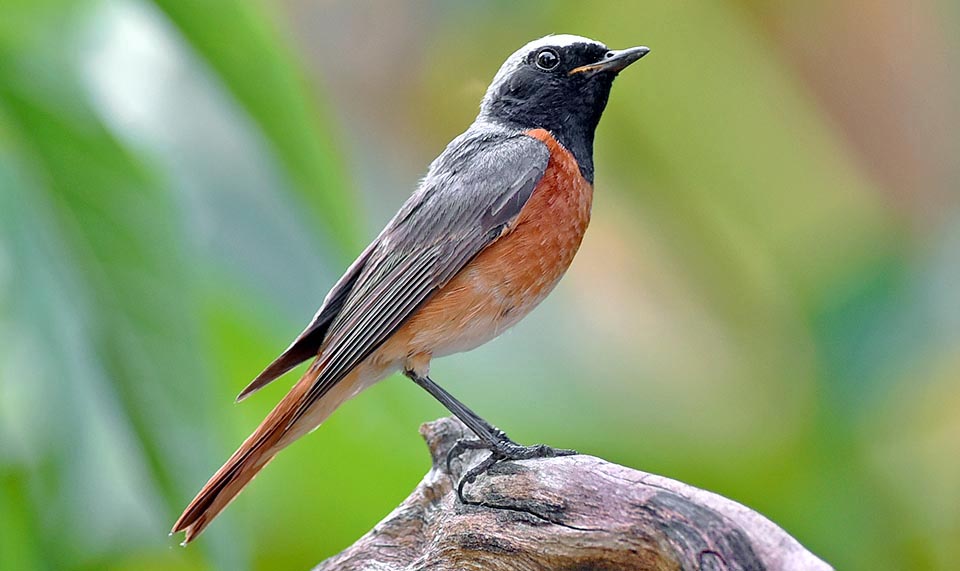
The Phoenicurus phoenicurus is a migrant who nidifies in the nice season in Europe, up to Siberia and China, but winters in tropical Africa or in the Arabian peninsula © Gianfranco Colombo
Birds having the same size, with similar morphological features, with eclipsal liveries almost the same and discoloured of their lively colours, such to render them at times indistinguishable and perfectly equal behaviours, here the confusion gets even bigger.
It is not rare, also among the numerous naturalist beginners, to hear of winter sightings of redstarts in one’s garden or on the window of some dwelling in full city, unaware that the true subject cited is presently staying at not least than some thousands of kilometres southward, as it is on the contrary matter of the successor, the black redstart. It is extremely easy to mistake them if the real facts are not known.
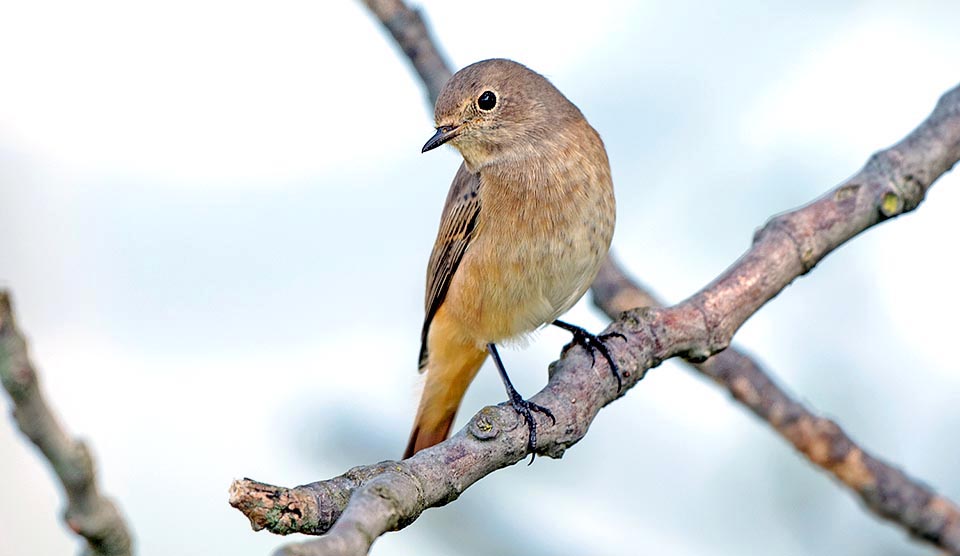
The sexual dimorphism is considerable and the female, apart the reddish tail, has a modest look, almost faded, in order not to attract the predators © G. Colombo
The English vulgar name Redstart, probably the most technically exploited in the ornithological world to indicate all those birds scattered in the world with these characteristics, literally translated might be interpreted as an unlikely “red departure” unconsciously coming to the same meaning, whilst the term simply comes from a wrong transcription of the old Anglo-Saxon name “steort”, rightly with the meaning of tail.
Therefore in the world ornithological literature we find repeated this name without knowing at times its meaning. For instance, Blackstart (Cercomela melanura) or a Red blackstart or viceversa Black redstart (both Phoenicurus ochruros) or even all our numerous palearctic redstarts.
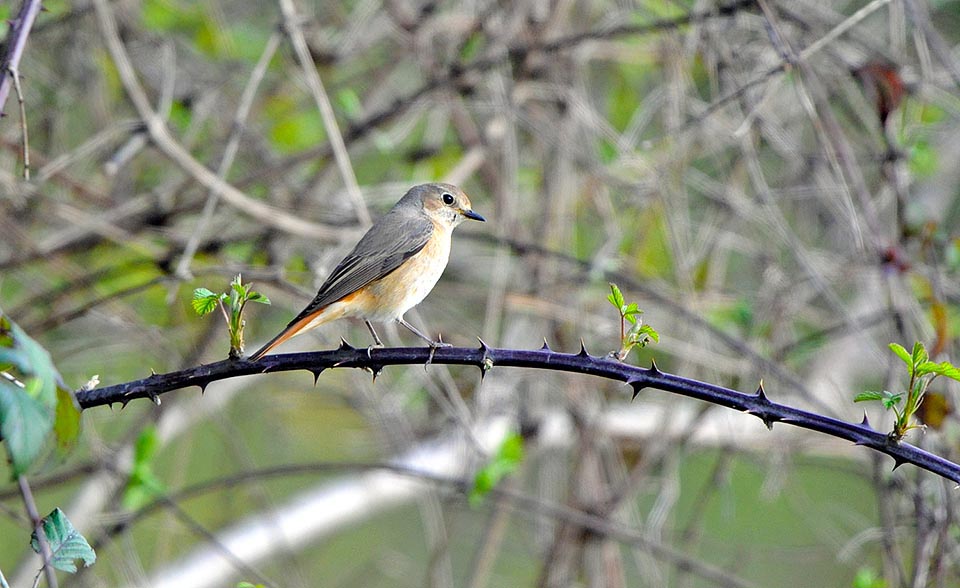
It goes almost unnoticed when hunts insects among the brambles and in late summer leaves, after having done the last refuel of energy with some sweetish berry © Gianfranco Colombo
As we said before, it is a solitary small bird, shy and wary and also inconspicuous, so much that often its presence goes unnoticed even if staying just out of the house door.
This species has had by sure a substantial support in the occupation of the anthropized world of the plains of the north of Italy, due to the abandonment by the peasants, as consequence of the drastic change occurred in the agricultural world during the last decades, of an impressive number of farmsteads and of farm houses scattered in the country, resulting in the creation of a new habitat done by desolated and wretchedly abandoned sites that however have become ideal environments for the presence of this small bird.

The song of the male is messy and little melodious but is enough for attracting the female in its alcove © Gianfranco Colombo
Here they have found a more protected habitat, an infinite series of ravines for a more secure nidification and in the mean time a considerable quantity of food.
It has not been difficult for those who had noted it for the first time, to give the generalized name of redstart to this small bird. All the vulgar names given by the populations sharing its presence, invariably report to this characteristic seen that it is the only sensation we can perceive in the very short time it gives us when suddenly flashes and darts in front of our eyes. An almost imperceptible flash of a small fluttering object of greyish colour, but that leaves traced while fleeing a virtual stream of a nice reddish colour.
The many common names, in particular of the extreme zones of North Europe, give the idea of how much is vast its summer expansion in the palearctic. In English it is called Common Redstart, in German Gartenrotschwanz, in Spanish Colirojo Real, in French Rougequeue à front blanc, in Portuguese Rabirruivo-de-testa-branca, in Italian Codirosso Comune or simply Codirosso and in Japanese an odd and unpronounceable Shirobitaijoubitaki.
The etymology of the scientific name Phoenicurus originates from the fusion of the old Greek language terms “phoinix” = purple red and “ouros” = tail and it is strange to observe how the genesis of the name given to the Phoenician people has the same origin, rightly because they were expert in extracting the red color used for their dyes from Murex brandaris, a gastropod now known as Bolinus brandaris.
Zoogeography
The redstart is a bird living in temperate ambients, cool and even with rather cold climates. It is a purely palearctic species during the period of nidification and occupies all European area up to the extreme north of the continent and at the same latitude up to Siberia, Lake Baikal and north-eastern China. In the south of its range it stops in the Central Asian republics, north of Iran and Anatolia.
Some populations are present also on the reliefs of western Mediterranean North Africa. Also in Italy it marks distinctly a bigger presence going northward leaving empty ample areas of the centre south of the peninsulaand of the major islands.

Here it is at the most of its modest splendor. It does not sing but replies softly with verses to the love call © Gianfranco Colombo
All populations winter in Africa or, for few and isolated central Asian populations, in the Arabian Peninsula. It is a long range trans-Saharan migrant and the belt of bigger winter concentration goes from the Atlantic Ocean coasts (Senegal) up to the Indian (Somalia) preferring the dry and shrubby environments of the savannahs and systematically avoiding the dense Equatorial forests. In the eastern part it reaches Tanzania following most probably the migratory path of the Rif Valley.
As occurs for many European migrants, the populations summering in the north, centre and west of the continent reach the winter quarters transiting over the Iberian Peninsula whilst the eastern Europe ones and most of the Asian ones, transit respectively from the Bosphorus and from the Arabian Peninsula.
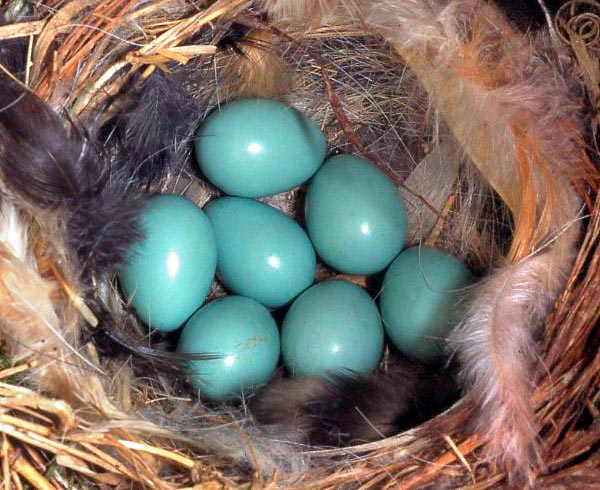
In the southern part of the summer range, the redstart can lay two broodings of 5-6 intense light blue eggs whilst in the northern quarters it limits to only one nesting © Museo Civico di Lentate sul Seveso
Two subspecies have been classified belonging to two distinct territories and with different migratory ways: Phoenicurus phoenicurus phoenicurus, present in all Europe, eastward up to north-eastern China and in Morocco and Algeria and Phoenicurus phoenicurus samamiscus, typical to south-eastern Europe and the far away Central Asian republics.
Ecology-Habitat
The redstart is a species typical to the areas delimited by broad leaves trees, even mixed with conifers and in the extreme north also with preeminence of the latter ones.
It loves staying on the margins of the forests and of the woody areas even if prefers for its hunting activity, open areas, orchards, bushy environments with fields even cultivated and with shrubs sufficiently tall and dense to grant it a long range vision without showing up, when lurking. As previously mentioned, it does not miss often to choose sites with completely different characteristics, such as city parks, gardens even if very small, abandoned dwellings, haylofts and also the full urban centre with the normal city vicissitudes.
Its reserved habit of hiding when in sylvan surroundings, decays strongly when inside an inhabited area. All its behaviour evidences unfailingly its usual habits shy and distrustful, in particular in the period of reproduction when alert and observant stays whole hours in some hidden fold of a pluvial or among the leaves of a small shrub or under a beam in almost full dimness, ready to emit its usual and startled uit uit uit, dry, short and persistent, as soon as it glimpses a danger. Only at that time we can detect its presence without even being able to observe it directly.

To nidify it often enjoys of the non frequented farmhouses. Here they have built the nest on a sill behind the closed shutter. Male and female slink between the blades alternating in nourishing the chicks © G. Mazza
In the other periods and clearly in the phase of courting and of conquest of the territory, here it is well in evidence on a dry twig on top of a small tree or on a high small wall or also on a chimney or on an electricity pole, emitting quite loudly that typical messy and not always melodious song for attracting the female to its alcove.
On that occasion it exhibits the best of itself, that is its garish livery, inflating the chest like a famous tenor.
Morpho-physiology
There is a strong sexual dimorphism between the two genders, so much to make them look as two distinct species if it was not for a commonality given by a well evident reddish tail, brought elegantly by both sexes.
The male has a garish livery with lively and bright colours, distinguishable from any other species or congener. The head is crowned on the front with a snow white with a hood that goes down to cover the shoulders and the remiges of an intense and compact ash grey colour.
On the face it has a very dark mask that starting just under the ocular line, surrounds the throat to touch the cheeks and then the nape, without merging. The chest is of an accentuated and brilliant orange red colour that shows then again on the tail and the back. The undertail is whitish. Moreover, the central feathers of the tail have a blackish nuance at times slightly accentuated. The legs and the bill are black.
The female has a rather faded livery is compared with the stateliness of the male’s one. The hatching tasks cannot give it such lively colours as they would render it visible in an extremely delicate moment of its life.
It has a very light orange grey colour all over the body, with the chest slightly more whitish and a hint of black on the head without any white crown, a humble livery enlightened only by an orange tail and back, but less accentuated than in the male.
In autumn the livery becomes more modest for both sexes. On the neck of the male appears a whitish small collar and all the colours reduce drastically and the female reduces even more the already poor brilliancy of its already modest shades.
The young during the first months of life have a whitish or ochraceous dotting on the lower parts of the body and a brownish mantle to then assume by the first juvenile moulting a livery much similar to the adult female but considerably more modest. Starting from the second year they will get the adult livery assuming more and more lively colours during the years.
The common redstart shows the typical movements of the body of all muscicapids, with continuous tremours of the tail, followed by rapid and short beats of the wings as well as of the tail, departures simulations with lowering of the body and finally rapid flights, short and sudden.
In these operations it is always very attentive even if alarmed by the approach of a danger and does not fail to seize preys also when it appears concentrated only on the forthcoming danger.
A quick flick upwards of a few metres or a simple fall like a dead weight to the ground for catching a flying small butterfly or to pick up an arthropod on the ground and then immediately at its place to signal the impending danger.
Its camouflaged flying away, silent and hidden, is on the contrary a masterpiece of mimicry. Typical of the period of nidification here it is throwing itself practically to the soil from its hidden stakeout and silently flying low over the surface, soaring vertically towards the chosen roost, with a manoeuvre difficult to follow.
The redstart is a small bird wih size similar to the traditional palearctic muscicapids. It is 14/15 cm long, weighs about 15 g and has a wingspan of about 25 cm.
Ethology-Reproductive Biology
In the southern part of the summer range, the redstart can make two broods of 5-6 intense light blue colour eggs whilst in the northern quarters it limits to only one nesting. This is a clear difference with its congener black redstart that conversely lays white coloured eggs.

The diet is very varied: small worms, small snails, spiders and insects of any kind including the caterpillars and here an impressive praying mantis © Gianfranco Colombo
The arrival of the female in the nidification sites occurs some days after the male’s arrival, who meawhile has already conquered an ideal territory that the female will only have to choose carefully. It is the female who builds the nest and to care the eggs whilst the male will control and defend the territory driving out possible intruders. It is a monogamous species for the nidification season only.
The nest is an often messy heap of dry herbaceous material, of moss and small rootlets that are piled inside the cavity usually chosen, forming a flared but comfortable cup, adorned with softer material and small feathers.

The chicks grow visibly spending in the nest 15-17 days from the birth. If they abandon it before the risks on the ground are enormous © Gianfranco Colombo
It often enjoys of the nest boxes when available or also placing the structure on small prominences of walls, porches, sills with windows ajar or abandoned nests of swallows. The brooding is done by the female and lasts about two weeks and the chicks, who are born blind and featherless, keep in the nest for 15/17 days more, cared incessantly and lovingly by both partners.
They are very territorial birds and fight fiercely any possible intrusion even if, unluckily, the species is frequently parasitized by the cuckoo with the well known final consequences.
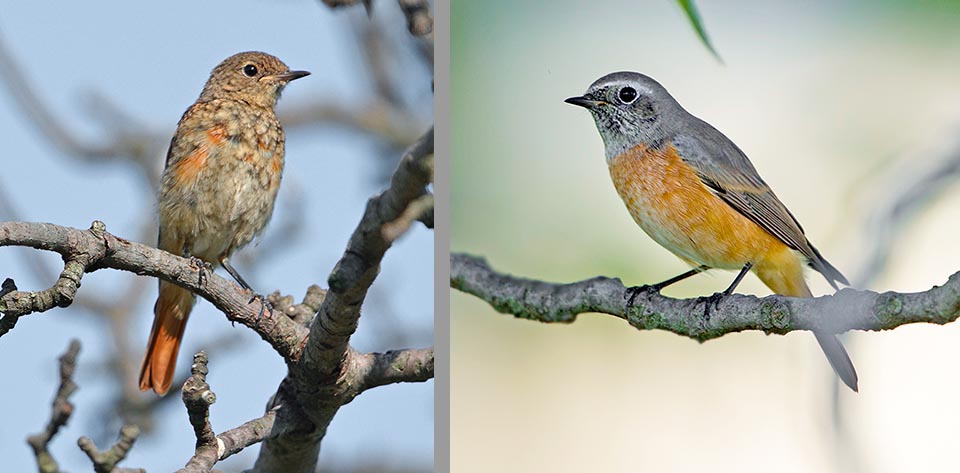
Young male at its first moulting and adult male just before migrating. In both cases the livery is very different © Gianfranco Colombo
As clearly cites the name of the family it belongs, the Muscicapidae, this species is purely insectivorous and nourishes indifferently of small coleopterans, of lepidopterans, of caterpillars and worms, of spiders and small snails but also of medium sized insects, at times unimaginable to gulp by the small nestlings but does not disdain in autumn, to eat sweetish berries and small juicy fruits for getting the fat necessary for the very long flight.
It is not an endangered species seen the vastity of the occupied territory, of the good consistency of the present populations and the good index of fertility. Populations are increasing and since 2016 Phoenicurus phoenicurus has been listed as “LC, Least Concern” in the IUCN Red List of Threatened Species.
Synonyms
Motacilla phoenicurus Linnaeus, 1758.
→ To appreciate the biodiversity within PASSERIFORMES please click here.
